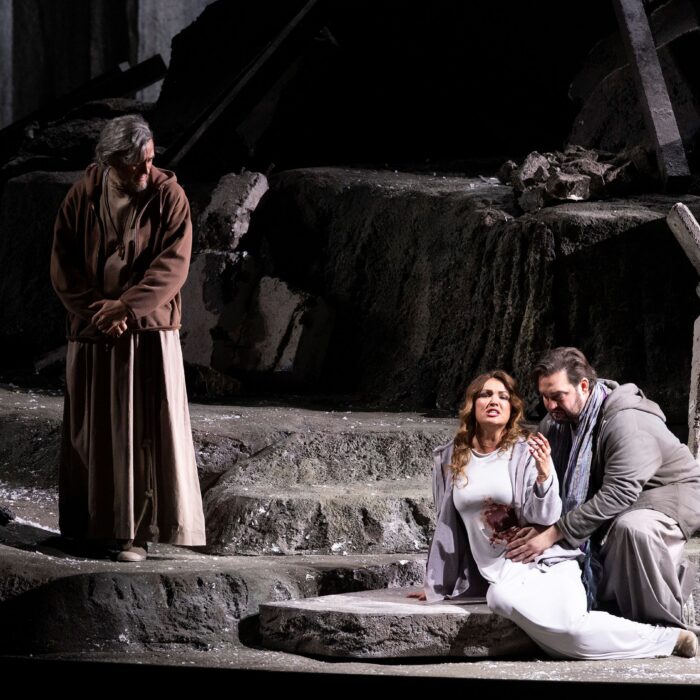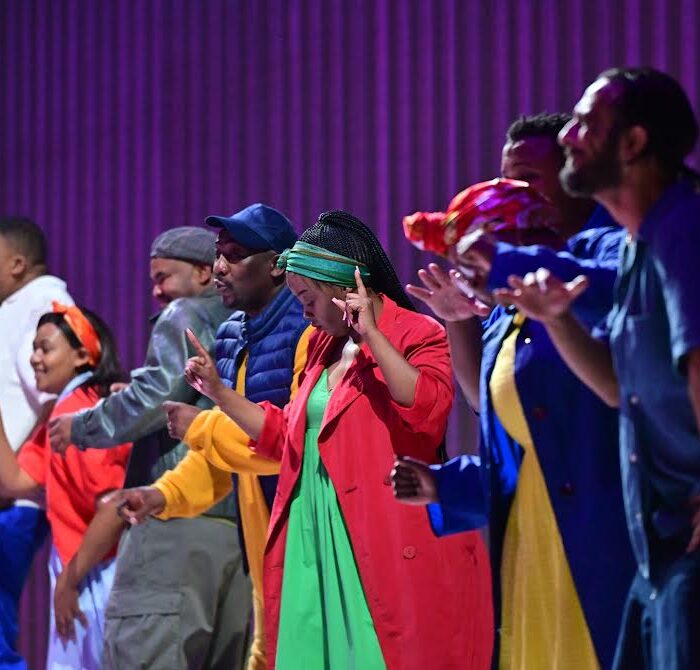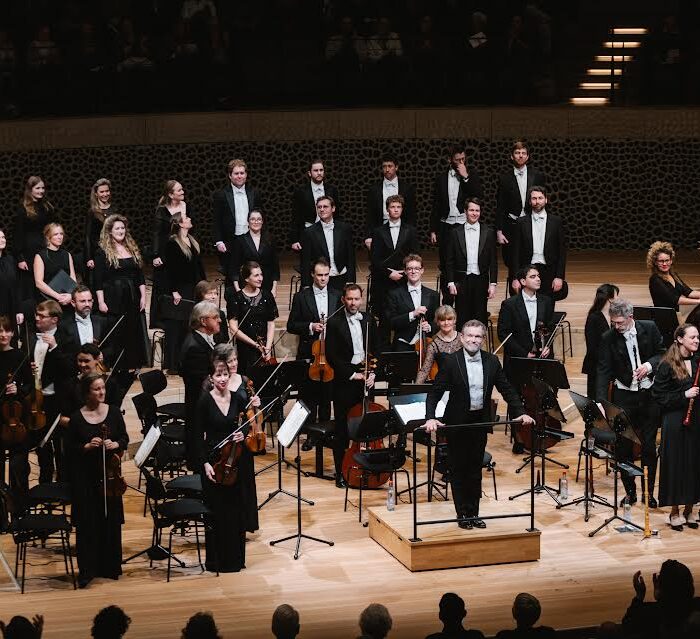
Opera Theatre Saint Louis 2024 Review: La Bohème
OTSL Successfully Stages Two Warhorses, With Puccini’s Winning
By Benjamin Torbert(Photo credit: Eric Woolsey)
No matter the repertory selected, Opera Theatre Saint Louis’s (OTSL) 2024 season would have faced a significant challenge: following their memorable 2023 season and its refreshing inclusion of many singers of color. Surrounding a forgettable “Cosí Fan Tutte,” three productions made maximal artistic impact, including a fine “Tosca” starring Katie Van Kooten and Hunter Enoch as Tosca and Scarpia, and a merry staging of Scott Joplin’s underrated and underperformed “Treemonisha,” now bookended by new outer acts composed by Damien Sneed and carried by charming interpretations from Justin Austin as Joplin/Remus and Brandie Sutton as Mrs Joplin/Treemonisha. But the crown jewel of 2023, and indeed several seasons prior, was Patricia Racette’s staging of Carlisle Floyd’s masterful, scathing indictment of social exclusion and scapegoating, “Susannah,” buoyed with time capsule-worthy performances by Janai Brugger in the title role and Freddy Ballentine as Sam Polk. The company seems to know what they accomplished; Brugger has landed on every promotional mailing this year, on new lobby signage directing patrons to the women’s restrooms, and even on the home screen of OTSL’s ticketing app for mobile phones. Ain’t it a pretty night, indeed.
For the grizzle-bearded operagoer, last year’s announcement of 2024’s lineup elicited two excited ‘oooohs’ for Handel’s “Julius Caesar” (1724) and Philip Glass’ “Galileo Galilei” (2002), and two overexposure-related ‘mehs,’ for “The Barber of Seville” (1816) and “La Bohème” (1896). Of course, one cannot structure an entire season with an eye towards what veteran audience haven’t heard in a long while, and though these works have been offered very recently in Saint Louis (“Barber” at Union Avenue Opera in 2021, and “Bohème” at UAO in 2019 and OTSL in 2016), curtain calls and seating maps make clear that few have tired of these works. Press releases boasted of significant numbers of new ticket buyers for both shows, and after some worryingly light attendance in 2022 following 2020’s cancellation and 2021’s de-densified performances in the east parking lot, seats fill more readily in 2024. Partly owing to a huge inheritance left by Phyllis Brissenden in 2020, the company’s future looks secure; five percent of capacity is reserved for free rush tickets, “Phyllis’s seats.” OTSL’s famed picnic pavilion—AKA “The Tent”—teems with operagoers pre-, mid-, and post-performance, this year serenaded by a septdecennial cicada chorus and unslowed by a suffocating belch of global warming.
Not always, but OTSL tends to open crowd-pleasing comic standard rep early in the festival season’s five and half weeks, and to wait until mid-June to unveil heftier, rarer, or more thought-provoking titles. In this context, “Barber” first made sense. While both stagings displayed qualities required for success and featured generous helpings of excellence both individually and in ensemble, the juxtaposition of the two works underscored the discrepancy between them. “Barber” has thrived despite its inherent flimsiness, while “La Bohème” offers even more magic on the hundredth viewing than the first.
I Didn’t Think She Was Gonna DIE; I Knew She Was Sick
Though weirdly polarizing among too-cool-for-school veteran audience, “La Bohème” remains unkillable, its glories undimmed by persistent overexposure—glance at North American opera companies’ schedules in 2024, and you’ll find “Bohème” nearly everywhere this year, commemorating Puccini’s death centennial. This opera works when casting top stars, when casting students, when casting mediocre professionals, when casting underrated professionals, and when casting Mirella Freni and Luciano Pavarotti at nearly triple the characters’ ages. It works when overselling and when underselling its steady current of comedy. “I had no idea ‘La Bohème’ was so funny,” reported my seat partner, who’d heard of but not seen the work—a covert endorsement, too, of OTSL’s English language project. It works set in 1830ish and it works set in 20-something. It doesn’t require, but works, with a concept staging and it works played straight. Back over a recording in your driveway, and the discs will probably still play. And better than most works, given its dialogic naturalism, the libretto survives translation into English. Unlike some Romance language titles (“Sister Angelica,” “The Pearl Fishers,” “The Turk in Italy”), OTSL refrains from attempting to Anglicize “La Bohème.”
OTSL employed the same translation they used in 2009 and 2016, by Richard Pearlman and Francis Rizzo. Rizzo has furnished opera companies with some of the best supertitles in the game. Recalling the company’s founding before the 1980s’ supertitle revolution, opera in English remains OTSL’s brand, and given the Tories’ recent budgetary assaults on English National Opera, OTSL may soon find itself the top-ranked English language opera company on earth. This is what OTSL does, and that’s fine—tiresome becomes arguing the very premise, but people still do in the lobby and at The Tent. If you want to hear original language, nearly every other company in the United States offers you a venue. But, the quality of the translation contributes mightily to greater or lesser success for the production. Italian operas fare better than slippery French libretti—OTSL performs few German or Russian operas, partly owing to the low capacity of the Loretto-Hilton Center’s pit. When interlocutors visit upon me the worn debate about opera in English, while expressing a preference for viewing works originally composed in English, I offer a salient comparison for how well or poorly the project can manifest. In consecutive seasons, 2018 and 2019, OTSL gave two works that couldn’t possibly provide more similar material with which the translator might labor, Verdi’s “Rigoletto” and “La Traviata”: same language, same composer, same librettist (Piave), and premiered just two years apart. But in execution, James’ Fenton’s translation of “Rigoletto” called little attention to itself and flowed with Verdi’s music and Piave’s dramatic momentum, while Edmund Tracey’s version of “La Traviata” bustled awkwardly about Violetta’s quarters and elicited laughs in noncomic moments.
The Pearlman/Rizzo translation renders “La Bohème” fluidly and naturally; upon receiving a print copy at the press table, I flipped immediately to “Sono andati,” scanned it, sung under my breath, and nodded with approval. (“Are they gone now? / I wasn’t really sleeping / Just pretending, so we could be alone”). The loveliest thirty seconds in the opera emerge under the weight of but one compulsory schwa, the best one can manage in twenty-first century Anglo-Saxon.
All Over Paris Chimneys on Ev’ry Rooftop Are Clouding up the Heavens
Michael Shell’s production placed the action in the early 1950s, aiming to “take us out of the social realism of the 30s and 40s into a new realm.” Shell also noted his team’s color palette, draining Acts three and four unto monochrome, as Mimì’s tubercular skin too would progress. Act two exploded with Christmasy red. “This setting epitomizes both the abstraction and the expressionism of art and the artist’s life at that time.” Directors say stuff like this. But the production worked well enough that we needn’t fork-test this concept too strenuously; if technicolorizing Acts one and two makes them more immediate, does grayscaling Acts three and four thrust them back into the social realism with which Shell associates the prior two decades? “Bohème” is about human life’s rent, all of it, coming due. Does the production then argue that the 1950s were a false fever-dream? I emerged from Shell’s comments wishing someone would stage Giordano’s “Fedora” in a film noir aesthetic, but unmotivated to pull any further at this thread. His “Bohème” worked for at least three reasons. First, “Bohème” just works. And second and third, the superb cast made it work and Shell’s team furnished the staging with sufficiently rich detail to give the opera the true-to-life character it requires—whether the director was claiming abstraction or not. “La Bohème” suffuses the listener with the living pulse of objects: Rodolfo and Marcello’s artistic implements, Mimì’s key, the candle, her bonnet, Musetta’s shoes and pawned jewelry, Colline’s coat, and most of all, that little hand muff. Mimì underlines this dynamic for the audience in “Donde lieta uscì.”
Takeshi Kata’s set for Acts one and four in the garret looked like you’d expect, a wood stove, an easel for Marcello and a small table hosting a Smith-Corona for Rodolfo. Atmospheric and oddly undistracting, Rodolfo clacked at the typewriter, backed by the usual stylized Parisian skyline, and a large platform with steps that gestured towards the entry stairwell from which Mimì visits the four guys. The backdrop and the social world disappeared in Act four, with a stark white wall growing the characters’ shadows as Mimì waned. Creating a slice of Paris on Christmas Eve doesn’t require the manpower Franco Zeffirelli demanded; about three dozen people populated Act two and its attractive Rat Pack-era restaurant, centering Musetta’s meta-performance of “Quando me’n vo” with one of those platinum mid-century radio microphones that make the vocalist look like they’re making love to it—at stage center, Brittany Renee’s aria, its two audiences (one onstage and one past the fourth wall) and her embrace of the mic recalled the public intimacy of Phedon Papamichael’s dolly shots of Joaquin Phoenix and Reese Witherspoon’s duets at the mic, as Johnny Cash and June Carter at the Grand Ole Opry in “Walk The Line” (2005). From Act three’s tavern exterior, stage right, stretched a low cinderblock wall, graffitied “L’amour est mort,” while the tavern’s sign read “Le couche du soleil,” en Français, both. The tavern may not sunset and love may not die entirely, but Mimì will by curtain. At the prima, a cicada graced us with its presence in the catwalk, making the quartet into a quintet; fortunately, it expired during Act four before the soprano’s character did. The only other element distracting from the drama was the furniture underneath her; not afforded a bed, she passed away semi-erect in an accent chair. Mimì lacked health insurance; as Chris Rock has observed, “at least if you got some coverage, you gonna die on a mattress.”
Mo’ Tussin
Soprano Katerina Burton breathed vivid simplicity and immediacy into the adorable seamstress’ death and life, clothed in a simple purple empire-waisted dress. A former Gerdine Young Artist at OTSL, she debuted here in the world premiere of Terence Blanchard’s “Fire Shut Up in My Bones” (2019). A full lyric, her timbre perfectly suits Mimì, a flavor like Godiva raspberry swirl ice cream, those swirls slender with a quick vibrato. Even before her first aria, “I’m always called Mimì” (“Si, mi chiamano Mimì”), she impressed with her acting, quiet-but-active actual listening to Rodolfo holding forth during “How cold your little hand is” (“Che gelida manina”). No showy reactions, just one smitten youth listening to another. When it was Burton’s turn, Moisés Salazar’s Rodolfo sat transfixed. Her inflections of the English text added to the storytelling, with extremely clear diction, “I often dream while working,” and she brought a sunnier color to “But when the winter’s over” (“Ma, quando vien lo sgielo”). In a nice touch from Seán Curran’s choreography, the chorus ensemble gathered about her and Rodolfo during “Can it be that I’m dreaming?” (“O soave fanciulla”), to remove the Act one set and usher in Act two’s, placing the couple’s outerwear on them. Mimì received a scarf of Serge Ibakan length, before giving Rodolfo the pull-back when he attempted to plant a kiss on her. Her famous bonnet at Café Momus hatched as a cute pillbox hat.
Mimì sometimes waits to break the audience’s heart till the end of Act three, but Burton commenced earlier. Something vocalists do, the best of them, is to communicate a simultaneously vulnerable and strong essence with the voice. Two exemplars are Renée Fleming singing and Jennifer Aniston talking. Burton approached the duet with Marcello sounding like she could endure anything, and also couldn’t endure much more. She spun delicate diminuendi in “Goodbye then, no sad farewells” (“Addio senza rancor”), communicating her waning spiritus. She embraced Rodolfo with pragmatism, communicating to the audience that Mimì is really the most adult in the group of six. Burton and Salazar blended well in the quartet “Goodbye to waking in the morning / with your arms around me” (“Addio dolce svegliare alla mattina”). Her chest and middle registers served her well throughout, particularly in “Are they gone now” (“Sono andati”), for which she stood from the chair, for the last time. Throughout, a sweet, earnest, very young but very grown up woman facing eternity. Burton will surely excel in varied full lyric repertory.
That’s My Vocation, Scribbling
Her boyfriend Rodolfo, tenor Moisés Salazar, also demonstrated the appeal of a young cast in an opera featuring young people. In his debut performances at OTSL, he brought a nearly spinto weight to the poet, secure, with some ping on top. His first act aria positioned Rodolfo with less macho swagger and more sheepish bookworm energy. His slightly awkward affect complemented Burton’s girl-next-door-ism, the two of them in concert drawing a stronger contrast with Marcello and Musetta’s lustier, messier inability to control themselves. In some ways, the former came off as earnest older kids and the latter as more jaded majors, but this actually delineated Rodolfo and Mimì as the more adult of the two couples. (Don’t forget, offstage events warrant Rodolfo’s jealousy; Puccini and the librettists cancelled an additional act between Acts two and three in which Mimì goes to stay with an older, more pecunious fellow who can afford medicine. Residue thereof colors Act three’s trio). Salazar also blended well with Tommy Glass’ Marcello in Act four’s duet, “Oh Mimì you’re gone forever” (“O Mimì tu più non torni”). Rodolfo must carefully calibrate his realization of her death, experiencing his own birth into a much colder world. Salazar absorbed the symphony of silent looks and gave utter brokenness in his final incantations of her name.
Your Friends Are There Waiting
The rest of the poet’s squad turned in strong performances, baritone Titus Muzi as Schaunard, bass André Courville as Colline, and especially baritone Thomas Glass as Marcello. Glass managed the trick of seeming more senior and worthy of being approached for advice when Rodolfo and Mimì squabbled, but incapable of minding his own shop maturely when Musetta dwelt anywhere proximate. The strongest singer of the male quartet, Glass projected warm overtones over a light-roast timbre. His Marcello never graduated to an unsloppy outfit, keeping the paint-stained shirt all evening, even when embracing Brittany Renee’s glam Musetta. Scratching Benoit’s head, he ably quarterbacked the amusing rent collection scene, assailing bass Robert Mellon’s Benoit. Mellon, clad in a housecoat that looked like a fire blanket, effectively portrayed a much older man. Courville’s Colline, producing a huge sound emerging from a slim fellow, won his spotlight moment, “Great-hearted coat, listen” (“Vecchia zimarra senti), with suitable secular-ecclesiastical gravitas. Muzi’s Schaunard, stronger in lower register than high, brought refreshments and sunnier affect than his three mopier compatriots struggle to generate. Muzi would later ace “Major Modern General” from “HMS Pinafore” in Center Stage, OTSL’s young artists’ showcase, prestissimo, after a stagy challenge from Maestra Daniella Candillari.
She Should Be Called Temptation
As Musetta, soprano Brittany Renee did exactly what Musetta ought, which is to steal the entire show, at least for an act. Her varied kit underscored a significant class difference between her and Mimì, and maybe the men as well. Remember, the four men may suffer from liquidity problems, but they talk and act in educated, bourgeois modes, they cite Greek mythology, and Rodolfo even reports an ailing rich uncle. Mimì, on the other hand, is poor, not broke. Musetta usually seems like she occupies the same class stratum as the men and merely digs gold from older, richer men than Marcello, but in this production her costumes and Renee’s bearing transmitted a true class difference, and the impression that messing with Marcello qualifies as slumming. Even though the libretto makes clear Mimì hasn’t met her before Christmas Eve, they cheek-kissed and spoke with the familiarity of old friends.
Renee flew onstage in a gold-plated gown, and a crimson wrap which she pointedly shed in Marcello’s direction before commencing “Whenever I go strolling on my own” (“Quando me’n vo,” probably the least felicitously translated passage). She delivered her hit song with a French vanilla timbre, sass, and sauce. Alcindoro always looks overmatched, but Mellon, in a tuxedo no less, got steamrolled by her regal, pop-idol antics. Amanda Seymour’s costume design took care of her in the second half too, a glamourous little black dress and pumps, as she won the argument with Marcello; ending the quartet they looked angrily at each other, began an obviously erotic embrace, and slammed the tavern door on the audience. Her prayer near the opera’s close landed so earnestly, and she ran out, crying, at Rodolfo’s pained ‘Mimì’s at curtain.
Conductor José Luis Gómez gets Puccini right, integrating the band and the stage forces so thoroughly that that they seemed to breathe as one. Puccini’s orchestra gets loud in some moments where Verdi’s doesn’t, and they never overwhelmed the singers, speaking with the proto-filmic idiom we so love from this composer. OTSL’s most recent “Bohème” delighted this audience and your fatigued reviewer alike, chiding anyone who might question its frequent programming. The stereotype about opera, of the consumptive heroine, seems to rest entirely on this work and “La Traviata”—rarely does one hear complaints about Antonia in “Les Contes d’Hoffman.” In this era when a global pandemic killed millions and closed our theaters, “La Bohème” presents as no cliché. It’s bulletproof.



